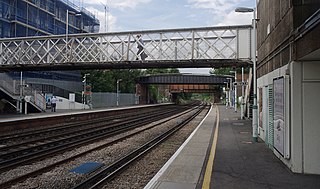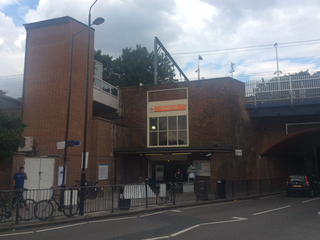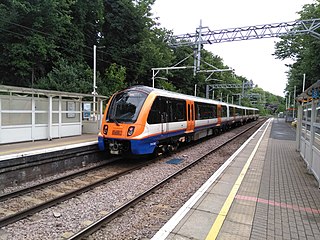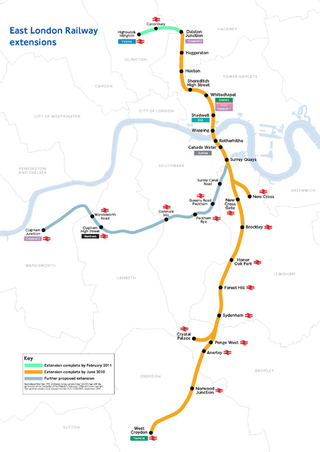
The Tube map is a schematic transport map of the lines, stations and services of the London Underground, known colloquially as "the Tube", hence the map's name. The first schematic Tube map was designed by Harry Beck in 1931. Since then, it has been expanded to include more of London's public transport systems, including the Docklands Light Railway, London Overground, the Elizabeth line, Tramlink, the London Cable Car and Thameslink.

Clapham Junction railway station is a major railway station and transport hub near St John's Hill in south-west Battersea in the London Borough of Wandsworth. It is 2 miles 57 chains from London Victoria and 3 miles 74 chains from London Waterloo; it is on both the South West Main Line and Brighton Main Line as well as numerous other routes and branch lines passing through or diverging from the main lines at this station. Despite its name, Clapham Junction is not located in Clapham, a district situated approximately 1 mile (1.6 km) to the south-east and is instead sited in Battersea.

The North London line (NLL) is a railway line which passes through the inner suburbs of west, north-west, north, and east London, England between Richmond in the south-west and Stratford in the east, avoiding central London. Its route is a rough semicircle.

The South London line is a railway line in inner south London, England. The initial passenger service on the route was established by the London, Brighton & South Coast Railway on 1 May 1867 when the central London terminal stations of Victoria and London Bridge were connecting to the inner south London suburbs of Clapham, Brixton, Camberwell and Peckham. Since 2012 passenger services have been part of London Overground and run between Clapham Junction and Peckham Rye continuing toward Highbury & Islington via the East London line. The line is 8.5 miles (13.7 km) long and consists of seven stations, one of which marks the crossover into the East London line network. Most of the line was built on a high level viaduct above other transport infrastructure. Interchanges with the London Underground are at Clapham High Street and the closest on its London Overground extension is Canada Water. The line is in Travelcard Zone 2.

Surrey Quays is a station on the East London Line of the London Overground. It is located in Rotherhithe, part of London Borough of Southwark. It is in Zone 2 and the next station to the north is Canada Water, and to the south it splits into branches to Clapham Junction, New Cross and Crystal Palace/West Croydon. Closed in late 2007, the station was refurbished and re-opened as part of the London Overground network on 27 April 2010.

Clapham High Street railway station is on the South London line in Clapham, within the London Borough of Lambeth, Greater London. It is 6 miles 21 chains (10.1 km) measured from London Bridge. It is served by London Overground services, with a limited service to Battersea Park under the control of the London Rail division of Transport for London.

Brockley railway station serves the south-east London district of Brockley and is on the main railway line between London Bridge and Brighton. It is 3 miles 56 chains down the line from London Bridge.

Gospel Oak railway station is in the London Borough of Camden in north-west London. It is on the North London line (NLL) and is also the western passenger terminus of the Gospel Oak to Barking Line – known informally as GOBLIN. Passengers using Oyster cards are required to tap on interchange Oyster card readers when changing between the two lines. The station is in Travelcard Zone 2, and is managed by London Overground which runs all passenger trains at the station.

The Gospel Oak to Barking line is a railway line in London. It is 13 miles 58 chains (22.1 km) in length and carries both through goods trains and London Overground passenger trains, connecting Gospel Oak in north London and Barking Riverside in east London. The line is part of Network Rail Strategic Route 6, and is classified as a London and South East Commuter line.

Kensington (Olympia) is a combined rail and tube station in Kensington, on the edge of Central London. Services are provided by London Overground, who manage the station, along with Southern and London Underground. It is in Travelcard Zone 2. On the Underground it is the terminus of a short District line branch from Earl's Court, originally built as part of the Middle Circle. On the main-line railway it is on the West London Line from Clapham Junction to Willesden Junction, by which trains bypass inner London. The station's name is drawn from its location in Kensington and the adjacent Olympia exhibition centre.

The West London line is a short railway in inner West London that links Clapham Junction in the south to Willesden Junction in the north. The line has always been an important cross-London link especially for freight services. Southern and London Overground provide regular passenger services; detailed below.

London Overground is a suburban rail network serving London and its environs. Established in 2007 to take over Silverlink Metro routes, it now serves a large part of Greater London as well as the home county of Hertfordshire, with 113 stations on nine different routes.

London has an extensive and developed transport network which includes both private and public services. Journeys made by public transport systems account for 37% of London's journeys while private services accounted for 36% of journeys, walking 24% and cycling 2%. London's public transport network serves as the central hub for the United Kingdom in rail, air and road transport.

Crossrail 2 is a proposed hybrid commuter rail and rapid transit route in South East England, running from nine stations in Surrey to three in Hertfordshire, providing a new North–South rail link across Greater London. It would connect the South West Main Line to the West Anglia Main Line, via Victoria and King's Cross St Pancras. It is intended to alleviate severe overcrowding that would otherwise occur on commuter rail routes into Central London by the 2030s. Should permission be granted, construction is expected to start around 2023, with the new line opening from the early 2030s. The project's cost has been estimated at £31.2 billion.

Old Oak Common (OOC) is a railway station under construction on the site of the Old Oak Common traction maintenance depot to the west of London in Old Oak Common, approximately 500 m (1,600 ft) south of Willesden Junction station. When built, it is expected to be one of the largest rail hubs in London, at about 800 m (2,600 ft) in length and 20 m (66 ft) below surface level.

East Brixton railway station was a railway station in Brixton, south London. It was opened as Loughborough Park by the London, Brighton & South Coast Railway in 1866. Regular passenger service was the South London line from London Victoria to London Bridge terminal stations in central London. Initially provided with a steam passenger service, competition from electric trams caused a conversion to overhead line electric operation in 1909. The station became part of the Southern Railway in 1923 and overhead line electrification was swapped for third rail in 1928. The station lost patronage after the opening of Brixton Underground station in 1971. There was a fire at the station in 1975 and it was closed by British Rail in January 1976. The station was located next to the rail bridge over Barrington Road, near Coldharbour Lane. Since 2012 London Overground trains pass through the site of the former station without stopping and there has been some campaigning to reopen it.

Urban or suburban rail plays a key role in public transport in many of the United Kingdom's major cities. Urban rail refers to the train service between city centres and suburbs or nearby towns that acts as a main mode of transport for travellers on a daily basis.

The East London line extension (ELLX) project was a British railway engineering project in London, managed by Transport for London. The project involved extending the East London Line and making it part of the mainline London Overground network. This was done by re-opening sections of disused railway line and by converting track electrified by the third-rail system, signalling, lineside signage and communication systems, etc. to mainline standards. New rolling stock was introduced and four new stations built along the route, with a fifth scheduled to be added in the future at New Bermondsey.

The West London Orbital is a proposed extension to the London Overground railway system. The extension would make use of a combination of existing freight and passenger lines including the Dudding Hill Line, North London Line and Hounslow Loop. The route would run for approximately 11 miles (17 km) from West Hampstead and Hendon at the northern end to Hounslow at the western end via Brent Cross West, Neasden, Harlesden, Old Oak Common, South Acton and Brentford.
Public transport in the London Borough of Havering, in east London, England, is a mix of National Rail, London Underground, London Overground and Crossrail and London Buses services. Rail services are primarily radial to central London with bus services providing most of the orbital connections. The public transport authority is Transport for London and the local authority is Havering London Borough Council.




















